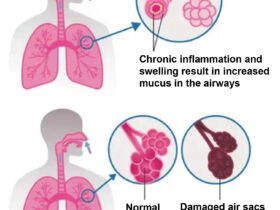By Brigid M. Bandy, RDH –
 No one wants to mention it, but everyone wishes someone would. To bring someone’s attention to their own halitosis (bad breath) is a delicate situation. Naturally, being in the dental field, I’ve had to broach this topic several times. After all, who wouldn’t want it brought to their attention to avoid future embarrassment?
No one wants to mention it, but everyone wishes someone would. To bring someone’s attention to their own halitosis (bad breath) is a delicate situation. Naturally, being in the dental field, I’ve had to broach this topic several times. After all, who wouldn’t want it brought to their attention to avoid future embarrassment?
So what it is halitosis? Halitosis is a condition characterized by consistently odorous breath caused by chemicals known as volatile sulfur compounds. In most cases, it comes from the mouth. The oral environment is dark, warm, and moist: the perfect breeding ground for more than 600 bacterial species that produce these sulfur compounds. The odors are produced mainly due to the breakdown of proteins from amino acids, which are further broken down into detectable foul gases.
Halitosis can have temporary causes such as morning breath, smoking, garlic or onion consumption, and can usually be relieved by brushing, flossing, and use of mouthwashes.
Chronic causes of halitosis include poor oral hygiene, periodontal disease, respiratory tract infections, chronic sinusitis and tonsillitis. These conditions are not easily remedied with just standard mouthwash and need to be addressed by specialists.
A common self-test for halitosis is to scrape the farthest back surface of the tongue with a spoon and then smell the drying surface. If you suspect you have bad breath, ask a spouse or a trusted friend for their honest opinion. If the answer is yes, make an appointment with a dentist to determine if you have periodontal disease, a food impaction problem, or faulty dentalwork. Unclean dentures are another source of halitosis.
Lack of proper hygiene allows bacteria and food to populate crevices between teeth, on the tongue, and under the gums, producing a putrescent smell. A thorough cleaning by a hygienist will remove plaque and calculus above and below the gumline. Temporary and periodic use of chlorhexidine, an antimicrobial rinse, can then be prescribed to eliminate volatile sulfur compounds. Daily toothbrushing, flossing, or use of an oral irrigator will maintain a fresh-smelling mouth. Over-the-counter products containing zinc (Smart Mouth) or chlorine dioxide (CloSys) help neutralize sulfur compounds in the mouth. Bacteria will repopulate the mouth so schedule cleanings and dental exams routinely and any problems can be identified and remedied in a timely manner.
Tongue bacteria account for many cases of mouth-related halitosis. The back third of the tongue is dry and not as self-cleansing as other areas on the tongue, making it an ideal habitat for bacteria that thrive on food particles. Mints and regular mouthwashes only mask odors and do not remove the source of the bacteria. In order to prevent volatile sulfur compound production, the bacteria on the tongue must be removed daily with a tongue cleaner, which is available at supermarkets or drug stores.
Another source of halitosis is tonsilloliths. Food bits and sinus secretions can accumulate in deep crevices or crypts in the tonsils causing stagnation, leading to an overgrowth of foul-smelling bacteria. Routine swishing and gargling any of the aforementioned rinses can control the strong odor of these calcified growths.
Chewing gum or mints a minimum of three times a day or after every meal, especially products sweetened solely with xylitol, has been shown to have a starving effect on bacteria. These products (Zapp, Xylichew, Spry, to name a few and available at health food stores ) reduce bacteria in the oral environment, including the bacteria responsible for tooth decay.
The social isolation and embarrassment from one’s oral malodor condition can be remedied and avoided if this topic is approached with sincere concern for a person’s well-being, restoring their ability to socialize with confidence.
Port Charlotte Dental
CALL TODAY: 941-764-9555









